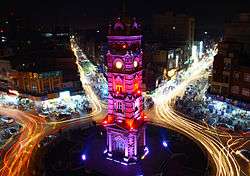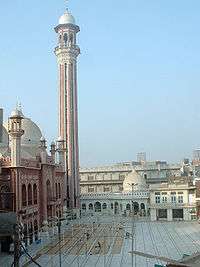Faisalabad
| Faisalabad فیصل آباد Lyallpur | |||
|---|---|---|---|
| City | |||
| |||
| |||
 Faisalabad Location of Faisalabad in Punjab, Pakistan | |||
| Coordinates: 31°25′45″N 73°4′44″E / 31.42917°N 73.07889°ECoordinates: 31°25′45″N 73°4′44″E / 31.42917°N 73.07889°E | |||
| Country | Pakistan | ||
| Region | Punjab | ||
| District | Faisalabad District | ||
| Former name | Lyallpur | ||
| Official language | Urdu | ||
| Native language | Punjabi | ||
| First settled | 1892 | ||
| Founded by | Sir Charles James Lyall | ||
| Government | |||
| • Type | Municipal Corporation | ||
| • Mayor of Faisalabad | TBD | ||
| • Deputy Mayor of Faisalabad | TBD | ||
| Area | |||
| • City | 1,300 km2 (490 sq mi) | ||
| • Land | 840 km2 (325 sq mi) | ||
| • Water | 430 km2 (165 sq mi) | ||
| • Metro | 5,860 km2 (2,261 sq mi) | ||
| Elevation | 184 m (605 ft) | ||
| Population (2016)[1] | |||
| • City | 4,075,000 | ||
| • Rank | 3rd, Pakistan | ||
| • Density | 3,200/km2 (8,300/sq mi) | ||
| Demonym(s) | Faisalabadi | ||
| Time zone | Pakistan (PST) (UTC+5) | ||
| • Summer (DST) | PST (UTC+4) | ||
| ZIP code(s) | 38000 | ||
| Area code(s) | 041 | ||
| Vehicle registration | Three letters beginning with F and random four numbers (e.g. FDA 1234) | ||
| Languages (1981) |
98.2% Punjabi 1.8% Others[2] | ||
| Website |
www | ||
Faisalabad (pronunciation: /fɑːɪsɑːlˌbɑːd/; Lyallpur until 1979), is the third-most-populous city in Pakistan, and the second-largest in the eastern province of Punjab. Historically one of the first planned cities within British India, it has long since developed into a cosmopolitan metropolis. Faisalabad was restructured into city district status; a devolution promulgated by the 2001 local government ordinance (LGO). The total area of Faisalabad District is 58.56 km2 (22.61 sq mi) while the area controlled by the Faisalabad Development Authority (FDA) is 1,280 km2 (490 sq mi).[3]:8 Faisalabad has grown to become a major industrial and distribution centre because of its central location in the region and connecting roads, rails, and air transportation.[4] It has been referred to as the "Manchester of Pakistan" because it contributes over 20% toward Pakistan's annual GDP.[5][6] Faisalabad's average annual GDP is $20.55 billion (USD),[7] of which 21% comes from agriculture.[3]:41
The surrounding countryside, irrigated by the lower Chenab River, produces cotton, wheat, sugarcane, vegetables and fruits. The city is an [industrial centre with major railway repair yards, engineering works, and mills that process sugar, flour, and oil seed. Faisalabad is a major producer of superphosphates, cotton and silk textiles, hosiery, dyes, industrial chemicals, beverages, clothing, pulp and paper, printing, agricultural equipment, and ghee (clarified butter). The Faisalabad Chamber of Commerce and Industry monitors industrial activity in the city and reports their findings to the Federation of Pakistan Chamber of Commerce and Industry and provincial government. The city has a major dry port and international airport.
Faisalabad is home to the University of Agriculture, Government College University as well as the Ayub Agricultural Research Institute, Divisional Public School Faisalabad and National Textile University.[3]:13 The city has its own cricket team, Faisalabad Wolves, which is based at the Iqbal Stadium.[8] There are several other sports teams that compete internationally, including hockey and snooker as well as other sporting events.[9]
History
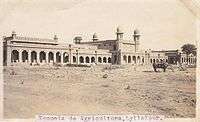
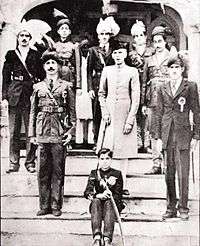

Toponymy
Faisalabad district actually began as Lyallpur district in 1904 and prior to that, was a tehsil of Jhang district.[11] During the British Raj, the city Lyallpur was named in honour of the then Lieutenant-Governor of Punjab, Sir James Broadwood Lyall, for his services in the colonisation of the lower Chenab Valley.[12] His surname Lyall was joined with "pur" which in old Sanskrit language means city.[13] In the late 1970s, the Government of Pakistan changed the name of the city from Lyallpur to Faisalabad (meaning City of Faisal), in honour of King Faisal of Saudi Arabia, who made several financial contributions to Pakistan.[14]
Early settlements
According to the University of Faisalabad, the city of Faisalabad traces its origins to the 18th century when the land was inhabited by a number of forest-dwelling tribes. It is believed these early settlements belonged to the ancient districts of Jhang and Sandalbar, which included the area between Shahdara to Shorekot and Sangla Hill to Toba Tek Singh.[15]
Colonial rule
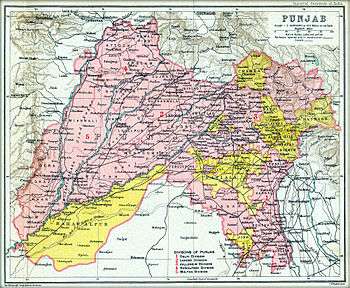
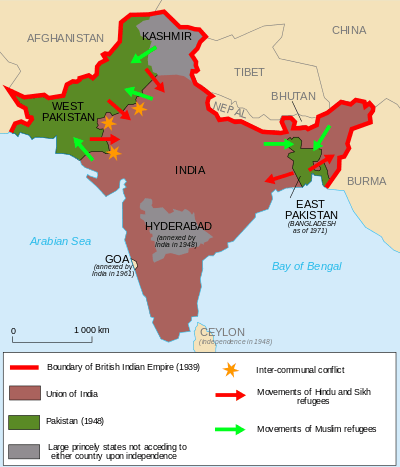
By the mid-18th century, the economic and administrative collapse of provinces within the Mughal Empire, from Punjab to Bengal, led to its dissolution.[16] Internal unrest resulted in multiple battles for independence and further deterioration of the region, which then led to formal colonialisation as established by the Government of India Act 1858, with direct control under the British Raj from 1858 to 1947.[17][18] In 1880, Poham Young CIE, a British colonial officer, proposed construction of a new strategic town within the area.[19] His proposal was supported by Sir James Broadwood Lyall and the city of Lyall was developed.[19] Historically, Faisalabad, (Lyallpur until 1979), became one of the first planned cities within British India.[20]
Young designed the city centre to replicate the design in the Union Jack with eight roads extending from a large clock tower at its epicentre;[21] a design geometrically symbolic of the Cross of Saint Andrew counterchanged with the Cross of Saint Patrick, and Saint George's Cross over all.[22] The eight roads developed into eight separate bazaars (markets) leading to different regions of the Punjab.[12][23] In 1892, the newly constructed town with its growing agricultural surplus was added to the British rail network.[24] Construction of the rail link between Wazirabad and Lyallpur was completed in 1895.[21] In 1896, Gujranwala, Jhang and Sahiwal comprising the Tehsils of Lyallpur were under the administrative control of the Jhang District.[11]
In 1904, the new district of Lyallpur was formed to include the tehsils of Samundri and Toba Tek Singh with a sub-tehsil at Jaranwala, which later became a full tehsil in itself.[25] The University of Agriculture, originally the Punjab Agricultural College and Research Institute, Lyallpur, was established in 1906.[10] The Town Committee was upgraded to a Municipal Committee in 1909. Lyallpur grew into an established agricultural tool and grain centre.[26] The 1930s brought industrial growth and market expansion to the textile industry as well as to food processing, grain crushing and chemicals.[12]
Independence

In August 1947, following three decades of nationalist struggles, India and Pakistan achieved independence. The British agreed to partition colonial India into two sovereign states – Pakistan with a Muslim majority, and India with a Hindu majority; however, more Muslims remained in India than what governing authorities believed would assimilate into Pakistan.[27] The partitioning led to a mass migration of an estimated 10 million people which made it the largest mass migration in human history.[27] India's Bengal province was divided into East Pakistan and West Bengal (India), and the Punjab Province was divided into Punjab (West Pakistan) and Punjab, India. There were also respective divisions of the British Indian Army, the Indian Civil Service, various administrative services, the central treasury, and the railways.[28] Riots and local fighting followed the expeditious withdrawal of the British, resulting in an estimated one million civilians deaths, particularly in the western region of Punjab.[27] Lyallpur, which was located in the region of the Punjab Province that became West Pakistan, was populated by a number of Hindus and Sikhs who migrated to India, while Muslim refugees from India settled in the district.[28]
In 1977, Pakistani authorities changed the name of the city to "Faisalabad" to honour the close relationship of King Faisal of Saudi Arabia with Pakistan.[29] During the eighties, the city realised an increase in foreign investment.[30] More Faisalabadis began working abroad as bilateral ties improved within the new dominion. This led to more monetary funds returning to the city that aided the development of the region.[14] In 1985, the city was upgraded as a division with the districts of Faisalabad, Jhang and Toba Tek Singh.[15]
Government and public services
1. Lyallpur Town
2. Madina Town
3. Jinnah Town
4. Iqbal Town
5. Chak Jhumra Town
6. Jaranwala Town
7. Samundri Town
8. Tandlianwala Town
Civic administration
Faisalabad was restructured into city district status; a devolution promulgated by the 2001 local government ordinance (LGO).[31] It is governed by the city district's seven departments: Agriculture, Community Development, Education, Finance and Planning, Health, Municipal Services, and Works and Services.[32] The district coordination officer of Faisalabad (DCO) is head of the city district government and responsible for co-ordinating and supervising the administrative units.[32] Each of the seven departments has its own Executive District Officer who is charged with co-ordinating and overseeing the activities of their respective departments.
The aim of the city district government is to empower politics by improving governance which basically involved decentralising administrative authority with the establishment of different departments and respective department heads, all working under one platform. The stated vision and mission of the city district government of Faisalabad is to "establish an efficient, effective and accountable city district government, which is committed to respecting and upholding women, men and children's basic human rights, responsive towards people's needs, committed to poverty reduction and capable of meeting the challenges of the 21st century. Our actions will be driven by the concerns of local people."[32]
Tehsil municipal administration
In 2005, Faisalabad was reorganised as a city district composed of eight Tehsil municipal administrations (TMAs).[33] The functions of the TMA include preparation of the spatial and land use plans, management of these development plans and exercise of control over land use, land sub-division, land development and zoning by public and private sectors, enforcement of municipal laws, rules and by-laws, provision and management of water, drainage waste and sanitation along with allied municipal services.[34]
There are 118 union councils in Faisalabad. Their role is to collect and maintain statistical information for socio-economic surveys. They consolidate ward neighbourhood development needs and prioritise these into union-wide development proposals. The council identifies any deficiencies in the delivery of these services and makes recommendations for improvement to the TMA.[35]
Faisalabad Development Authority
The Faisalabad Development Authority (FDA) was validly established in October 1976 under The Punjab Development of Cities Act (1976) to regulate, supervise and implement development activities in its jurisdiction area.[36][37] The FDA acts as a policy-making body for the development of the city and is in charge of arranging and supervising major developments within the city. It is responsible for the administration of building regulations, management of parks and gardens and subsoil water management. The FDA works with the Water and Sanitation Agency (WASA) to control and maintain the water supply, sewerage and drainage.[38] The FDA works to improve conditions in the slums.[39]
Healthcare
Healthcare services are provided to the citizens by both public and private sector hospitals. The government–run hospitals are Allied Hospital, District HQ Hospital, Institute of Child Care,[40] PINUM Cancer Hospital, Faisalabad Institute of Cardiology (FIC) and General Hospitals in Ghulam Muhammadabad and Samanabad.[41] There are a number of private hospitals, clinics and laboratories in the city, notably Al-Rahmat labs, Mujahid Hospital lab, National Hospital lab & Agha Khan lab.[42][43]
Law enforcement
Law enforcement in Faisalabad is carried out by the city police, under the command of the city police officer (CPO), an appointment by the provincial government.[44] The office of the CPO is located in the District Courts, Faisalabad.[45] Various police formations include district police, elite police, traffic police, Punjab highway patrolling, investigation branch, and special branch.[46]
Water supply and sanitation
The Water and Sanitation Agency (WASA), is a subsidiary of Faisalabad Development Authority (FDA), established 23 April 1978 under the Development of Cities Act 1976.[47] 2015 estimates indicate that WASA provides about 72% of the city's sewerage services and about 60% of their water services.[48] The existing production capacity of WASA is 65 million imperial gallons per day (300 million litres per day), almost all of which is drawn from wells located in the old beds of the Chenab River. From the wells, water is pumped to a terminal reservoir located on Sargodha Road.[49] Water is normally supplied for a total of about 8 hours per day to the majority of the city.[49] The Japan International Cooperation Agency (JICA) has provided financial and hardware equipment to help improve the water and sanitation conditions in the city.[50]
Geography
Location
Faisalabad lies in the rolling flat plains of northeast Punjab, at 184 metres (604 ft) above sea level. The city proper comprises approximately 1,230 square kilometres (470 sq mi) while the district encompasses more than 16,000 square kilometres (6,200 sq mi). The Chenab River flows about 30 kilometres (19 mi), and the Ravi River meanders 40 kilometres (25 mi) to the southeast. The lower Chenab canal provides water to 80% of cultivated lands making it the main source of irrigation. Faisalabad is bound on the north by Chiniot and Sheikhupura, on the east by Sheikhupura and Sahiwal, on the south by Sahiwal and Toba Tek Singh and on the west by Jhang.[51]
 |
Sargodha | Chiniot | Sheikhupura |  |
| Jhang | |
Nankana Sahib | ||
| ||||
| | ||||
| Gojra | Samundri | Tandlianwala and Okara |
Geology
The district of Faisalabad is part of the alluvial plains between the Himalayan foothills and the central core of the Indian subcontinent.[52] The alluvial deposits are typically over a thousand feet thick.[53] The interfluves are believed to have been formed during the Late Pleistocene and feature river terraces.[54] These were later identified as old and young floodplains of the Ravi River on the Kamalia and Chenab Plains. The old floodplains consist of Holocene deposits from the Ravi and Chenab rivers.[55]
The soil consists of young stratified silt loam or very fine sand loam which makes the subsoil weak in structure with common kankers at only five feet. The course of the rivers within Faisalabad are winding and often subject to frequent alternations. In the rainy season, the currents are very strong. This leads to high floods in certain areas which do last for a number of days. The Rakh and Gogera canals have encouraged the water levels in the district however the belt on the Ravi River has remained narrow. The river bed does include the river channels which have shifted the sand bars and low sandy levees leading to river erosion.[53]
Faisalabad is situated at the centre of the lower Rechna Doab, the area is located between the Chenab and Ravi rivers. There is a mild slope from the northeast to the southwest with an average fall of 0.2–0.3 metres per kilometre (1.1–1.6 feet per mile). The city is situated at an elevation of about 183 metres (600 ft). The topography is marked by valleys, local depression and high ground.[56]
Climate
The weather in the city is monitored by the Pakistan Meteorological Department.[57] The Pakistan Meteorological Department regularly provides forecasts, public warnings and rainfall information to farmers with the assistance of the National Agromet Centre.[58][59] Faisalabad has been classified as a hot desert climate (BWh) by the Köppen-Geiger climate classification system.[60]
Average annual rainfall is approximately 375 millimetres (14.8 in) and highly seasonal. It is usually at its highest in July and August during monsoon season.[56] Record-breaking rainfall of 264.2 millimetres (10.40 in) was recorded on 5 September 1961 by the Pakistan Meteorological Department.[61] Observations from the Meteorological Observatory at the University of Agriculture indicate that overall rainfall levels in the city have increased by 90.4 millimetres (3.56 in) over the course of thirty years.[62]
| Climate data for Faisalabad | |||||||||||||
|---|---|---|---|---|---|---|---|---|---|---|---|---|---|
| Month | Jan | Feb | Mar | Apr | May | Jun | Jul | Aug | Sep | Oct | Nov | Dec | Year |
| Record high °C (°F) | 26.6 (79.9) |
30.8 (87.4) |
37 (99) |
44 (111) |
47.5 (117.5) |
48 (118) |
46.1 (115) |
42 (108) |
41.1 (106) |
40 (104) |
36.1 (97) |
29.2 (84.6) |
48 (118) |
| Average high °C (°F) | 19.4 (66.9) |
22.2 (72) |
27.4 (81.3) |
34.2 (93.6) |
39.7 (103.5) |
41.0 (105.8) |
37.7 (99.9) |
36.5 (97.7) |
36.6 (97.9) |
33.9 (93) |
28.2 (82.8) |
22.1 (71.8) |
31.6 (88.9) |
| Average low °C (°F) | 4.8 (40.6) |
7.6 (45.7) |
12.6 (54.7) |
18.3 (64.9) |
24.1 (75.4) |
27.6 (81.7) |
27.9 (82.2) |
27.2 (81) |
24.5 (76.1) |
17.7 (63.9) |
10.4 (50.7) |
6.1 (43) |
17.4 (63.3) |
| Record low °C (°F) | −4 (25) |
−2 (28) |
1 (34) |
7 (45) |
13 (55) |
17 (63) |
19 (66) |
18.6 (65.5) |
15.6 (60.1) |
9 (48) |
2 (36) |
−1.3 (29.7) |
−4 (25) |
| Average precipitation mm (inches) | 16 (0.63) |
18 (0.71) |
23 (0.91) |
14 (0.55) |
9 (0.35) |
29 (1.14) |
96 (3.78) |
97 (3.82) |
20 (0.79) |
5 (0.2) |
2 (0.08) |
8 (0.31) |
346 (13.62) |
| Source: [63] | |||||||||||||
Demographics
| Population growth | |||
|---|---|---|---|
| Census | Pop. | %± | |
| 1941 | 69,930 | ||
| 1951 | 179,000 | 156.0% | |
| 1961 | 425,240 | 137.6% | |
| 1972 | 823,344 | 93.6% | |
| 1981 | 1,104,209 | 34.1% | |
| 1998 | 2,008,861 | 81.9% | |
| Figures based on the 2004 Baseline Survey conducted by the Asian Urban Information Centre of Kobe[56] | |||
Faisalabad was established as one of the first planned towns of British India covering an area of 3 square kilometres (1.2 sq mi).[64] It was initially designed to accommodate 20,000 people. The city's population increased from 69,930 in 1941 to 179,000 in 1951 (152.2% increase).[65] Much of the increase is attributed to the settlement of Muslim refugees from East Punjab and Haryana, India. In 1961, the population rose to 425,248, an increase of 137.4%. Faisalabad set a record in the demographic history of Pakistan by registering an overall population increase of 508.1% between 1941 and 1961. The industrial revolution of the 1960s contributed to population growth.[65] In 1961, the population was 425,248. A 1972 census ranked Faisalabad as the 3rd largest city of Pakistan with a population of 864,000. In a 1981 census, the population was 1,092,000; however, the Faisalabad Development Authority estimated the number to be 1,232,000.[65] A 2014 demographic profile shows the population count at 3.038 million.[66]
Religion and ethnic groups
The province of Punjab, in which Faisalabad is the second largest city, has prevalent sociocultural distinctions.[68] Population sizes vary by district but some distinguishing factors include a young age structure, high age dependency ratio, a higher percentage of males, a higher proportion of married population, and heterogeneity in castes and languages.[68]:387
Islam is the common heritage in the region with a 97.22% Muslim majority according to the 1998 Pakistan census report and 2001 population data sheet.[68] Islamic influences are evident in the fundamental values of various inhabitants including cultural traditions, marriage, education, diet, ceremonies and policies with may reflect stark differences in rural villages as compared to urban areas.[69] People live in tight-knit joint families, although a nuclear family system is emerging due to changing socio-economic conditions.[68] Ancient Pakistani culture prevails in most marriage practices in the region, as do certain restrictions related to ethnicity and caste. However, the influences of more modern societies have effected some change, particularly in the area of the dowry system. As of 2016, monogamous and polygamous unions remain an acceptable marriage practice.[70] In following ancient culture, marriages are customarily arranged by the parents or matchmakers. In some instances, the husband must buy his wife from her parents.[70] Marriage ceremonies, which can be more or less formal, include rituals which are universal in nature and hold sociological importance.[69] Studies conducted in 2007 and 2013, the latter in an outlying rural village in Faisalabad District, acknowledged the existence of gender bias and discrimination against females, stating that "Gender discrimination is not a new phenomenon", and that it still exists in the modern world.[68][69] It was further noted that situations may be worse in villages because "whenever a girl is born, nobody celebrates her birth, whereas when a boy is born, it means great joy and celebration."[69]
Social change in the region has been a slow process but there are indications that change has occurred as more villages are exposed to various forms of media and modernized urban communities. It is further noted that there has been a "conscious and persistent effort" to educate rural and urban societies about gender bias and equality.[69] In early 2014, there was a march known as the "White Ribbon Campaign" which took place in front of the Faisalabad Press Club. Protestors appealed to the government to adopt new laws "to protect women who are discriminated against in the family and workplace."[71]
Prevalent minorities, particularly Hindu and Christian, feel a sense of vulnerability because of their religious beliefs.[67] Labourers and farmhands comprise the countless Christian villages throughout Punjab; many are descendants of people who converted from Hinduism to Christianity under the British Raj, and considered low caste by virtue of their birth.[27] A small population of wealthy, well-educated Christians have settled in Karachi; however, as a result of increasing Islamization, religious intolerance in Pakistani society, blashphemy laws and Islamist militancy, most have left Pakistan to settle in other countries where there is more religious tolerance, such as Canada and Australia.[67][72]
| Rank | Language | 1988 census[68]:388 |
|---|---|---|
| 1 | Muslim | 97.22% |
| 2 | Christian | 2.31% |
| 3 | Ahmadi | 0.25% |
| 4 | Hindu | 0.12% |
| 5 | Scheduled castes | 0.03% |
| 6 | Others | 0.06% |
Languages
Punjabi is the dominant language spoken by over three-fourths of the population.[68] In the south-southwest regions, Saraiki is the common language. The national language is Urdu, which is customarily used between various ethnic groups.[68]
| Rank | Language | 1988 census[68]:388 |
|---|---|---|
| 1 | Punjabi | 75.23% |
| 2 | Saraiki | 17.36% |
| 3 | Urdu | 4.54% |
| 4 | Pashto | 1.16% |
| 5 | Balochi | 0.66% |
| 6 | Sindhi | 0.13% |
| 7 | Others | 0.95% |
Economy
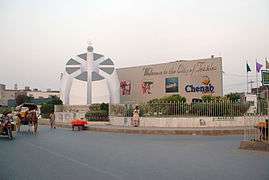
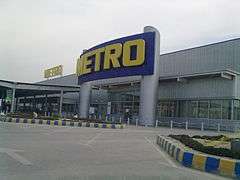
Faisalabad contributes over 20% toward Pakistan's annual GDP; therefore, it is often referred to as the "Manchester of Pakistan".[5][6] Faisalabad's average annual GDP is $20.55 billion (USD),[7] of which 21% comes from agriculture.[3]:41 The surrounding countryside, irrigated by the lower Chenab River, produces agricultural commodities such as cotton, rice, sugarcane, wheat, fruit and vegetables.[73][74] The city has carved a niche as an industrial centre with its highways, railways, railway repair yards, processing mills, and engineering works. It is a producer of industrial goods and textile manufacturing including cotton and silk textiles, super phosphates, hosiery, dyes, industrial chemicals, clothing, pulp and paper, printing, agricultural equipment, ghee (clarified butter), and beverages.[75]
The Faisalabad Chamber of Commerce and Industry monitors industrial activity in the city and reports their findings to the Federation of Pakistan Chamber of Commerce and Industry and provincial government.[76] The city has a major dry port[3]:25 and international airport.[3]:26
Faisalabad is recognised as the centre of the textile industry in Pakistan, contributing to half of Pakistans total textile shipments.[77] At the end of June 2012, textile mills employed 20% of the nation's workforce, and generated 1.3 trillion rupees ($13.8 billion) in textile products, most of which were exported to the US and Europe.[77] While Punjab's economy is driven primarily by agriculture, the textile industry along with leather products and light engineering goods play an important role, with more than 48,000 industrial units spread across Punjab.[78] In an effort to boost bilateral trade, Romania and Turkey have honorary-consulates in Faisalabad which enable trade links with the city.[79][80]
The Faisalabad clock tower and its eight bazaars (markets) remain a major trading zone in the city.[81] Each of the eight bazaars has a special name and is known for selling certain goods as follows:[82]
- Katchery Bazaar, named for the court (Katchery) is known for its mobile phone and accessory market.
- Rail Bazar is a gold and cloth market.
- Bhawana Bazaar supplies electrical and electronic goods.
- Jhang Bazaar supplies fish, meat, vegetables and fruits.
- Aminpur Bazaar supplies stationery and interior décor.
- Kharkhana Bazaar is known for herbal medicines.
- Gol Bazaar contains dry fruit, as well as wholesale soap, oil, and ghee shops.
- Chiniot Bazaar is known for allopathic and homoeopathic medicinal stores, cloth, blankets, sofa cloth, and curtains. It also has poultry feed wholesale shops.
- Montgomery Bazaar (also known as Sutar Mandi) is known for yarn and raw cloth trading.
Faisalabad has received substantial funding from the government of Punjab and the city district government to improve infrastructure and roads to rural areas.[83] In an effort to deal with the energy crisis, the FCCI has been working with private companies to develop renewable energy resources such as solar energy and the construction of dams within the district.[84] CAE, a German-based renewable energy company, has disclosed plans to establish the first solar panel manufacturing facility in Faisalabad, second of its kind in Asia, with intentions of investing upwards of €100 million (Rs 12.9 billion) for its development.[85]
Transportation

Faisalabad is well-connected by rail, road and air. Public transportation in Faisalabad includes auto-rickshaws, buses and railways. Faisalabad International Airport is located on the outskirts of the city, and operates flights to the Middle East.[88]
Road
The majority of roads are under the control of the National Highway Authority, linking Faisalabad with other cities in the country.[89]
National highways and motorways passing through Faisalabad
Faisalabad is connected to various parts of the country by several National Highways and Motorways:[49][89]:maps
- The Grand Trunk Road, otherwise known as GT Road, is the original highway that links Faisalabad to most parts of Pakistan as well as neighbouring countries. GT Road was the main highway that ran through the district before the completion of the motorways.[90]
- The M3 motorway (Pakistan) or M3 is an access-controlled motorway connecting Faisalabad with the M2 motorway (Pakistan) or M2 via the Pindi Bhattian Interchange. The M2 was the first motorway connecting Rawalpindi and Islamabad to Lahore.[89]:6
- The M4 motorway (Pakistan) or M4 is an access-controlled motorway connecting Faisalabad to Multan. The M4 once complete will join the M5 which will run to the southern city of Karachi.[91]
The district government has worked with the National Highway Authority to connect Multan and Faisalabad.[92] The construction of the M4 is scheduled for completion by 2019. The new motorway will help reduce congestion, boost trade, and reduce travel times and transportation costs from Faisalabad, a major textile hub to the major trade centre of Multan.[91] One section of the M4 was inaugurated on 16 March 2015 which links Faisalabad to Gojra.[93]
Buses
The Faisalabad Urban Transport System Service (FUTS) is the main bus operator within the city. It was launched in 1994, and operates a number of large CNG buses and smaller Toyota hiace vans connecting the majority of the city.[94] There is another public-private run bus operator, Brothers Metro, which is a consortium between the government of Punjab and a private firm who operates a fleet of air-conditioned CNG buses.[95]
Rail
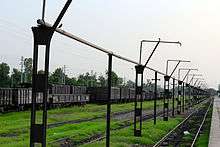
The Faisalabad railway station is the central railway station in the city. The railway line forms part of the Khanewal–Wazirabad railway line. Rail services are operated by Pakistan Railways, owned and operated by the Ministry of Railways.[96]
Cargo Express services are operated by Pakistan Railways which runs from Karachi to Faisalabad via Multan. Twenty-seven bogies comprise the goods train, and are handled respectively by private contractors at the station.[97] The station has a special cargo facility operated by the Ministry of Railways (Pakistan) for handling various goods from the city to other regions of the country. An express parcel service runs from Karachi to Lahore via Faisalabad.[98]
Air traffic
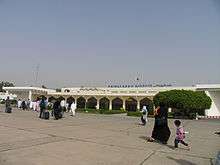
Faisalabad International Airport is approximately 15 kilometres (9.3 mi) from the city centre and is a major airport for domestic and international travel. The airport includes a cargo facility. As of January 2016, passenger flights are run by the national flag carrier, Pakistan International Airlines, and a number of middle eastern carriers. There are seasonal Hajj operations to Jeddah and Medina operated by Shaheen Air.[100] FlyDubai became the first international carrier to launch operations from the city followed by Qatar Airways, Air Arabia and Gulf Air.[101][102]
In 2015, significant upgrades and renovations to the airport were initiated by the Pakistan Civil Aviation Authority, including updates to aviation technology, construction of additional areas and services for travellers, and the expansion of air traffic capabilities to accommodate wide-body aircraft such as the Boeing 777.[103]
Culture


Faisalabad, the third most populated metropolis in Pakistan after Karachi and Lahore[106] is an epicentre for trade that has gained popularity for its colonial heritage sites.[107] In 1982, the Government of Punjab established the Faisalabad Arts Council, a division of the Punjab Arts Council which is overseen administratively by the Information, Culture and Youth Affairs Department.[108] The Faisalabad Arts Council building, designed by architect Nayyer Ali Dada, was completed in 2006. The auditorium was named after the late Nusrat Fateh Ali Khan, a Pakistani musician and singer.[108]
Festivals
The Punjabi people celebrate a variety of cultural and religious festivals throughout the Punjab region, such as arts and craft, music, local events, and religious celebrations.[109] The city of Faisalabad customarily celebrates its independence day on 14 August every year by raising the Pakistan flag at the clock tower in the Commissioner Office compound. Bazaars are colourfully decorated for the celebration, government and private buildings are brightly lit, and there are similar flag–raising ceremonies that are typically held in the district and its tehsils.[110][111]
The arrival of spring brings the annual "Rang-e-Bahar" festival where the Parks & Horticulture Authority of the city district government organise a flower show and exhibition at Jinnah Gardens.[112] The University of Agriculture organises a similar event at their main campus which is known as the "Kissan Mela".[113] The festival of Basant which involves kite flying is an annual tradition in the city despite the ban.[114] The provincial government introduced the "Canal Mela" which involves five days of festivities including the main canal in the city being decorated with national floats and lights ending with a musical concert to conclude the festival.[115]
Being a Muslim majority the city religious observances include Ramadan and Muharram. The festivals of Chaand Raat, Eid al-Fitr and Eid al-Adha are celebrated and are national holidays.[116] The celebration of the Prophet Muhammad birthday is observed in the city which is often referred to as "Eid Milād-un-Nabī".[117] There are a number of darbar and shrines which attract a number of devotees during the annual Urs.[118] There are a number of Christian churches in the city where Easter and Christmas services take place each year.[119][120]
Attire
Traditional attire in Faisalabad is Punjabi clothing such as the dhoti, kurta and pagri.[121] Faisalabadi men wear white shalwar kameez as do women but also with a dupatta (scarf). The more conservative women wear burqas that may or may not cover the face.[121] Combinations of Pakistani and Western attire are worn by women, such as an embroidered kurta worn with jeans or trousers, and half sleeve or sleeveless shirts with Capri pants. Men have adopted some of the modern Western styles for both casual and formal business dress such as dress pants, trousers, T-shirts and jeans.[121]
Faisalabad Institute of Textile and Fashion Design at the Government College University (Faisalabad) teaches Fashion Design as part of their Fine Arts program.[122] Some of the more conservative establishments and universities follow strict dress codes, such as the National Textile University in Faisalabad where a notice was issued on 27 April 2016 by university professor Muhammad Ashfaq. The intent of the notice was to "promote a positive image of the NTU and to maintain good moral, religious and cultural values among the faculty, staff and students." The dress code bans certain styles of Western attire including shorts, sleeveless shirts and shawls for men. Women are prohibited from wearing jeans, tights or leggings, sleeveless or half-sleeved shirts for women. Women are also prohibited from wearing heavy make-up and expensive jewellery.[123]
Cuisine
Faisalabadi cuisine is very much Punjabi cuisine, with influences from the realms of the Mughal and Colonial empires. Key ingredients include rice or roti (flatbread) served with a vegetable or non-vegetable curry, a salad consisting of spiced tomatoes and onions, and yogurt. This is usually accompanied by a variety of South Asian sweets such as jaggery, gajar ka halwa, gulab jamun, and jalebi.[124] Tandoori barbecue specialties consist of a variety of naan bread served with tandoori chicken, chicken tikka or lamb shishkebab served with a mint chutney.[125]
Street foods are a key element to Faislabadi cuisine.[126] Samosas (deep fried pastry filled with vegetables or meat) topped with an onion salad and two types of chutney. There is even a square dedicated to them in the old city.[127] Other street foods include, dahi bhale (deep fried vadas in creamy yoghurt), gol gappay (fried round puri filled with vegetables and topped with tamarind chutney) and vegetable or chicken pakoras. Biryani and murgh pilao rice are a speciality in Faisalabad.[128]
A typical breakfast in Faislabadi is halwa poori comprising a deep fried flatbread served with a spicy chickpea curry and sweet orange coloured halwa.[127] It is customarily accompanied by a sweet or salty yoghurt based drink called lassi.[129] During winter, a common breakfast is roghni naan bread served with paya curry.[130]
Specialty drinks vary depending on climate. During winter, a variety of hot drinks are available, such as rabri doodh, a creamy dessert drink commonly made with full-fat milk, almonds, pistachios and basil seeds, dhood patti (milky tea), and Kashmiri chai, a pink coloured milky tea containing almonds and pistachios.[131] During summer, drinks such as sugar cane rusk, limo pani (iced lemon water), skanjvi (iced orange and black pepper) and lassi are common.[132]
There are American-style fast food franchises that cater to the local community such as McDonald's, Kentucky Fried Chicken (KFC), and Pizza Hut.[133]
Literacy
According to a report by the United Nations Educational, Scientific and Cultural Organisation (UNESCO), the 2015 literacy rate for Pakistan ranked 160th which is among the lowest literacy rates in the world.[134]
In 1981, Faisalabad was among four districts in Punjab, which included Gujranwala, Jhelum and Gujrat, that were experiencing low literacy rates, due primarily to either a lack of resources or family pressure; the latter of which may also be attributable to illiteracy.[134] In 1998, Faisalabad progressed to a higher literacy rate with the most improvement realised at the primary school level.[135] In 2008, Faisalabad District ranked 51.9% which placed the district 9th in literacy out of the 34 Punjab districts.[136]
In 2014, the city held its first literary festival which brought a number of writers to the city to encourage the community to follow the arts.[137] Two literary groups were established, the Faisalabad Union of Column Writers and Faisalabad Union of Journalists, to bring together printed media personalities for the purpose of providing training to budding writers from the city.[138]
Recreation
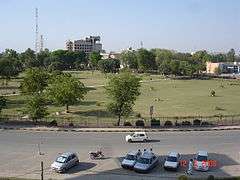
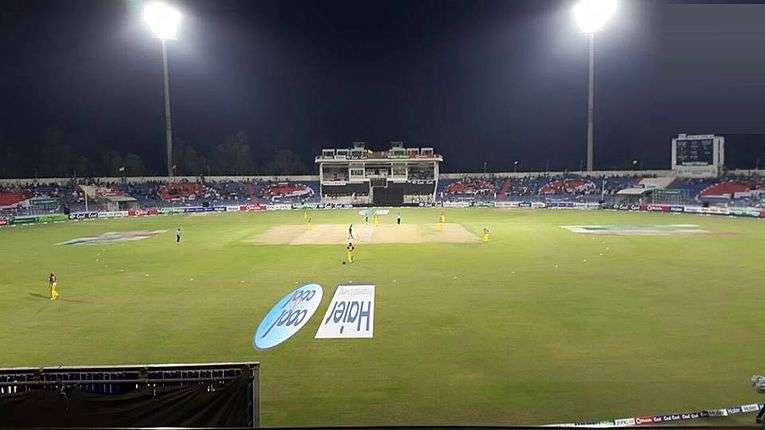
Parks and open spaces
Faisalabad is home to a number of parks, most of which are maintained by the Parks and Horticulture Authority, Faisalabad.[139] The oldest park in the city is Jinnah Garden, the city's central park, commonly known as "Company Bagh" and where the monument of Sir Charles James Lyall is situated.[139]
Other parks include Canal Park, a family park located on the west bank of the Rakh Branch Canal.[14] The Gatwala Wildlife Park is a botanical natural reserve located at Gatwala that was renovated by the city district government.[140] The Pahari Grounds near D Ground is another renovated park that has a Pakistan Air Force F-86 Sabre on display.[141]
Sports
Cricket is a popular sport in Faisalabad. Regional and international cricket matches are held in Iqbal Stadium,[8] named after Pakistani poet Sir Allama Muhammad Iqbal.[142] The stadium is home to Faisalabad's local team, the Faisalabad Wolves.[143] Iqbal Stadium hosted the 1987 Cricket World Cup,[144] and the 1996 Cricket World Cup.[145]
The Faisalabad Hockey Stadium located on Susan Road was constructed in 2002, and can accommodate 25,000 spectators. On 16 April 2003, the stadium was inaugurated by Khalid Maqbool, governor of Punjab. It is the third largest hockey stadium in the country.[146] The stadium has hosted field hockey matches for both national and international competition but by the beginning of 2016 was reported to be in "pathetic condition as its astroturf has completed its life span about eight years ago." Commissioner Naseem Nawaz advised that efforts were under way to maintain the stadium.[146]
In October 2002, the Government College University established a Directorate of Sports to promote university and national level sports for male and female players. Infrastructure and facilities are available for university players in track, hockey, tennis, basketball, table tennis, badminton and cricket pitch.[147]
Education
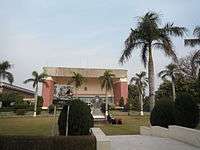
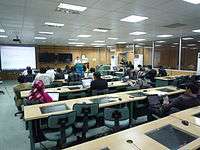
The population of Faisalabad has a literacy rate of approximately 60%, with a split of 69% for males and 46% for females (all figures are higher than the national average within the country).[148]
Faisalabad has several research and educational institutions, both public and private, such as the University of Agriculture, Government College University, National Textile University, Nuclear Institute for Agriculture and Biology, University of Faisalabad, and the University of Engineering & Technology of Lahore.[149] In 2014, the University of Agriculture ranked 1st in agriculture and 4th overall for universities in Pakistan according to the Higher Education Commission of Pakistan (HEC), and was ranked 142nd in the 2013 Top 200 World Universities for agriculture and forestry by Quacquarelli Symonds (QS).[150]
Education system
The education system is monitored by the District Education Officer of the City District Government of Faisalabad.[151] The city government reports its findings to the Ministry of Federal Education and Professional Training and the Minister for Education. Funding is provided by the Government of Punjab, Pakistan, City District Government and the fees collected from schools. There are four levels of the education system in the city: Primary, Elementary, High and Higher Secondary Level. Primary level education is only compulsory.[152] There are a number of schools for the assistance of children with special needs.[153]
Public libraries and museums
There are two libraries that are open to the public: Allama Iqbal Library and Municipal Corporation Public Library. They are funded and regulated by the Government of Punjab, Pakistan under the service sector.[154]
- Allama Iqbal Library is located on University Road, opposite the District Courts. The library is housed in the 1911-built colonial building originally named "Coronation Library" during the rule of the British Empire. In 2012, the building came under control of the Lyallpur Heritage Foundation[155] and the Punjab Archives and Libraries Department.[156]
- Lyallpur Museum is located adjacent to the Allama Iqbal Library on University Road. It is a heritage museum and art gallery open to the public. The museum is primarily focused on regional history with a collection of artwork, artefacts and photographs.[157]
- Municipal Library is located in Iqbal Park on Narwala Road, opposite the historical grounds of Dhobi Ghat.[158] The library has a large collection of books, a photo gallery and a conference centre. In 2011, the library underwent a renovation costing 40 million rupees.[159]
- The Forest Library at the Punjab Forestry Research Institute (PFRI) is one of two specialist libraries, the other being in Lahore.[160] Opened in 1986, the research library is based at the Wildlife Research Center in Gatwala.[161]
Media
Television and radio
The Pakistan Electronic Media Regulatory Authority (PEMRA) is responsible for the regulation and monitoring of electronic media entertainment in the country.[162] Pakistan Television Corporation, is the state-owned regulated television broadcasting network.[163] The government began licensing private broadcasters in 2002.[164]
The government of Pakistan installed the first radio transmitters in the city on 15 September 1982.[165] "Radio Pakistan" broadcasts three government regulated FM stations: "Radio Pakistan FM101, Radio Pakistan FM93 and Radio Pakistan Sautul Qur'an Channel FM93.4. FM101 became operational in 2002, FM93 went live in 2010 and FM93.4 Sautul Qur'an Channel went live in 2016; PBC all three stations are standard power KW 2.5.[166]
Telecommunications
Pakistan Telecommunication Authority is a government-owned organisation that is responsible for the establishment, operation and maintenance of telecommunications in the city.[167] The organisation monitors and prevents illegal exchanges in the city.[168]
Pakistan Telecommunication Company Limited is the main provider of fixed line, mobile and broadband services. Regional headquarters is located at the Central Telecom House in Chinot Bazaar.[169] With the deregulation of the telecommunication sector by the Ministry of Information Technology, a range of companies now offer mobile and broadband services in the city.[170]
Film and theatre
In 2008, the Government of Pakistan lifted a forty-year ban on Bollywood films which allowed Indian films to be played in cinemas.[171] The cinema industry has since seen the introduction of new cinemas such as Cinepax by Hotel One,[172] and Cine Nagina.[173]
The Government College University in Faisalabad encourages students from the University of Agriculture to hold workshops and explore themes of peace and tolerance which can be used in an engaging and entertaining way to communicate complex issues to different audiences.[174]
See also
References
- ↑ http://citypopulation.de/world/Agglomerations.html
- ↑ Stephen P. Cohen (2004). The Idea of Pakistan. Brookings Institution Press. p. 202. ISBN 0815797613.
- 1 2 3 4 5 6 Ghulam Mustafa (2009). Regional Profile, Faisalabad (PDF) (Report). University of Agriculture, Faisalabad.
- ↑ "The City Faisalabad – GCUF".
- 1 2 International Conference on Soil Sustainability and Food Security (PDF) (Report). University of Agriculture, Faisalabad. 2005. Retrieved 7 June 2016.
- 1 2 Jaffrelot, Christophe (2002). Pakistan: Nationalism Without A Nation. Zed Books. p. 57. ISBN 978-1-84277-117-4.
- 1 2 "Lloyd's City Risk Index". 2015–2025 Risk Index Research by Loyd's and the Cambridge Centre for Risk Studies. University of Cambridge Judge Business School. Retrieved 29 November 2015.
- 1 2 Andrew McGlashan. "Iqbal Stadium". ESPN Sports Media Ltd. Retrieved 20 December 2015.
- ↑ "Punjab International Sports Festival Begins". Pakistan Today. 8 November 2012. Retrieved 17 June 2016.
- 1 2 "Faculty of Agriculture – History". University of Agriculture, Faisalabad. Retrieved 7 June 2016.
- 1 2 "History of Faisalabad". Punjab Portal. Retrieved 8 June 2016.
- 1 2 3 Integrated Slums Development Programme (ISDP) (March 2001). "Faisalabad CITY PROFILE and SELECTION OF WARDS". Retrieved 8 July 2015.
- ↑ "Spoken Sanskrit Dictionary". Retrieved 11 June 2016.
- 1 2 3 4 "A History of Faisalabad City". The Faisalabad Chamber of Commerce & Industry. Retrieved 8 July 2015.
- 1 2 "City of Faisalabad". The University of Faisalabad. Retrieved 4 December 2015.
- ↑ Gordon, Leonard A.; Walsh, Judith (2009). "Central Themes for a Unit on South Asia". Asia For Educators. Columbia University. Retrieved 17 June 2016.
- ↑ Stein, Burton (2010). A History of India. John Wiley & Sons. p. 107. ISBN 978-1-4443-2351-1. Quote: "When the formal rule of the Company was replaced by the direct rule of the British Crown in 1858, ...."
- ↑ Lowe, Lisa (2015). The Intimacies of Four Continents. Duke University Press. p. 71. ISBN 978-0-8223-7564-7. Quote: "... Company rule in India lasted effectively from the Battle of Plassey in 1757 until 1858, when following the 1857 Indian Rebellion, the British Crown assumed direct colonial rule of India in the new British Raj."
- 1 2 "Brief History of Faisalabad". District Court of Faisalabad. Retrieved 8 June 2016.
- ↑ "The City Faisalabad". Government College University Faisalabad. Retrieved 17 June 2016.
- 1 2 "Brief History of Faisalabad". District Court Faisalabad. Retrieved 3 December 2015.
- ↑ Nicolls, Bruce. "The Union Jack or The Union Flag?". The Flag Institute. Retrieved 3 December 2015.
- ↑ "City of Faisalabad". The University of Faisalabad. Retrieved 3 December 2015.
- ↑ Dan Bogart, Latika Chaudhry (August 2011). "Railways in Colonial India: An Economic Achievement?" (PDF). Social Sciences. University of California-Irvine. p. 2. Retrieved 3 December 2015.
- ↑ "Imperial Gazetteer of India". 2. Superintendent of Government Printing. 1908: 220–223.
- ↑ Nausheen Anwar (2014). Infrastructure Redux: Crisis, Progress in Industrial Pakistan & Beyond. Pakistan: Palgrave Macmillan. p. 119. ISBN 978-1-137-44818-7.
- 1 2 3 4 Crispin Bates, Phd (3 March 2011). "The Hidden Story of Partition and its Legacies". British History. BBC. Retrieved 4 December 2015.
- 1 2 Yasmin Khan (2007). The Great Partition: The Making of India and Pakistan. Yale University Press. ISBN 978-0-300-12078-3.
- ↑ Shahid Javed Burki (2015). Historical Dictionary of Pakistan. Rowman & Littlefield. p. 196. ISBN 978-1-4422-4148-0.
- ↑ "Business ties: Faisalabad encourages Turkish investment". The Express Tribune. 26 April 2015.
- ↑ Urban Management Initiatives in Pakistan (PDF). Pakistan Research Repository, Influence of the Development Plan on City Growth (Report). Pakistan Higher Education Commission. pp. 84–85. Retrieved 19 January 2016.
- 1 2 3 "CDG Faisalabad – Welcome...".
- ↑ "CDG Faisalabad". faisalabad.gov.pk. Government of Punjab. Retrieved 7 June 2016.
- ↑ "TMA Faisalabad Division". lgcd.punjab.gov.pk. Government of Punjab. Retrieved 7 June 2016.
- ↑ Bhalli, Nasar min Allah. "Union Council Boundaries of Faisalabad City". Department of Geography, GUCF. Pakistan GIS. Retrieved 17 June 2016.
- ↑ http://www.urbanunit.gov.pk/PublicationDocs/28.pdf Assessment of Land Development and Management Practices in Five Large Cities of Punjab
- ↑ "The Punjab Development of Cities Act, 1976".
- ↑ "Water And Sanitation Agency" (PDF). Retrieved 8 June 2016.
- ↑ "Application of GIS in the Spatial Analysis of Slums in Faisalabad, Pakistan". Retrieved 8 June 2016.
- ↑ "CDG Faisalabad". www.faisalabad.gov.pk. City District Government Faisalabad. Retrieved 7 June 2016.
- ↑ "FIC Official Website". FIC. Retrieved 22 November 2013.
- ↑ "Government Hospitals of Faisalabad". Punjab.gov.pk. Retrieved 22 November 2013.
- ↑ "List of Public and Private Health Care Facilities". Faisalabadcity.net. Retrieved 22 November 2013.
- ↑ Hanif, Intikhab (16 February 2007). "Government Puts A Whole New Complexion on Police". Dawn. Retrieved 8 June 2016.
- ↑ "Contact Us Faisalabad City Police". Retrieved 17 November 2015.
- ↑ "Faisalabad Police". Faisalabad Police. Archived from the original on 10 February 2015. Retrieved 8 June 2016.
- ↑ "Water Supply". wasafaisalabad.gop.pk. Water and Sanitation Agency Faisalabad. Retrieved 7 June 2016.
- ↑ "The City Faisalabad". wasafaisalabad.gop.pk. Water and Sanitation Agency Faisalabad. Retrieved 7 June 2016.
- 1 2 3 Mahboob Elahi (12 June 2007). Performance Benchmarking in WASA Faisalabad (PDF) (Report). Anjuman Samaji Behbood. Retrieved 7 June 2016.
- ↑ "Japan gifts WASA Faisalabad with Equipment to improve Sewerage and Drainage system". www.jica.go.jp. Japan International Cooperation Agency. Retrieved 7 June 2016.
- ↑ "CDG Faisalabad". www.faisalabad.gov.pk. City District Government Faisalabad. Retrieved 7 June 2016.
- ↑ "Pakistan". Washington Post. Retrieved 9 June 2016.
- 1 2 Akhtar, Nasim (October 2006). "Study Area and Sampling" (PDF). Radionuclide Pollution due to Fertilizer use in some Saline Soils of the Punjab and their Potential Risk Assessment on Human Health (PhD). Bahauddin Zakariya University. Retrieved 7 June 2016.
- ↑ Giosan, Liviu; Clift, Peter D.; Macklin, Mark G.; Fuller, Dorian Q.; Constantinescu, Stefan; Durcan, Julie A.; Stevens, Thomas; Duller, Geoff A. T.; Tabrez, Ali R.; Gangal, Kavita; Adhikari, Ronojoy; Alizai, Anwar; Filip, Florin; VanLaningham, Sam; Syvitski, James P.M. (26 June 2012). "Fluvial Landscapes of the Harappan Civilization" (PDF). PNAS. National Academy of Sciences. 109 (26): E1688. Bibcode:2012PNAS..109E1688G. doi:10.1073/pnas.1112743109. PMC 3387054
 . PMID 22645375. Retrieved 9 June 2016.
. PMID 22645375. Retrieved 9 June 2016. - ↑ Jehangir, Waqar Ahmed; Qureshi, Asad Sarwar; Ali, Nazim (2002). "Physiography of the Rechna Doab". Conjunctive Water Management in the Rechna Doab: An Overview of Resources and Issues. International Water Management Institute. p. 3. ISBN 9290904895.
- 1 2 3 "Report of Baseline Survey Faisalabad, Pakistan". Asian Urban Information of Kobe. Retrieved 27 January 2016.
- ↑ "Pakistan Weather". Pakistan Meteorological Department. Retrieved 17 June 2016.
- ↑ "Weather Advisory for Farmers". Pakistan Meteorological Department. Retrieved 17 June 2016.
- ↑ "Regional Agrometeorological Center Faisalabad". Pakistan Meteorological Department. Retrieved 7 June 2016.
- ↑ "Climate: Faisalabad – Climate graph, Temperature graph, Climate table". Climate-Data.org. Retrieved 7 September 2013.
- ↑ Pakistan Meteorological Department http://www.pmd.gov.pk/ Retrieved 18 January 2016
- ↑ "Climatic Trends in Faisalabad (Pakistan) Over the Last 60 Years (1945–2004)" (PDF). Retrieved 9 June 2016.
- ↑ "Faisalbad Climate Data". Archived from the original on 13 June 2010. Retrieved 18 January 2011.
- ↑ India Unbound: from Independence to the Global Information age by Gurcharan Das
- 1 2 3 "Chapter 6: Faisalabad, Pakistan". The 2004 Baseline Survey on Millennium Development Goals in AACs. Asian Urban Information Center of Kobe. 2004. Retrieved 4 December 2015.
- ↑ "Major cities – population". Pakistan Demographics Profile 2014. IndexMundi. 2014. Retrieved 4 December 2015.
- 1 2 3 "Who are Pakistan's Christians?". BBC. 23 September 2013. Archived from the original on 3 March 2016. Retrieved 7 June 2016.
- 1 2 3 4 5 6 7 8 9 Asad Ali Khan (December 2011). "Changing Pattern of Population Growth and Structure in Punjab, Pakistan" (PDF). South Asian Studies. 26 (2): 387–388.
- 1 2 3 4 5 Ambreen, Mamonah; Mohyuddin, Anwaar (February 2013). "Gender Discrimination Tactics Used Against Females". International Journal of Scientific & Engineering Research. ISSN 2229-5518. Retrieved 21 July 2016.
- 1 2 Masood, Saira; Batool, Zahira; Abbasi, Saif-Ur-Rehman Saif (2007). "Sociological Study of Marriage Patterns and Adjustment in a Selected Community in Faisalabad City (Pakistan)" (PDF). Journal of Agriculture & Social Sciences. 3 (1): 1. Retrieved 21 July 2016.
- ↑ Kholkar, Shafique (3 March 2014). "Faisalabad: Hundreds of "White Ribbons" to Protest Against Violence Against Women". AsiaNews. Retrieved 21 July 2016.
- ↑ "Pakistani Christian refugees face ordeal in Thailand". FOX News Network, LLC. 3 August 2015.
- ↑ "Culture". Faisalabad.com. Retrieved 19 June 2016.
- ↑ "Agricultural Production: 'Fertiliser Use Models Made For Farmers' Benefit'". The Express Tribune. 6 December 2015. Retrieved 19 June 2016.
- ↑ Batool, Amina; Shaheen, Salma; Majeed, Samina; Kahn, Rao Shehzad Akhtar Alli; Kahn, Muhammad Hayat; Gulshan, Abid Hussain. "Faisalabad Industrial Cluster" (PDF). Scope and Development of Industrial Clusters in Pakistan. Directorate of Training and Research, Lahore. p. 10. Retrieved 19 June 2016.
- ↑ "THE FAISALABAD CHAMBER OF COMMERCE & INDUSTRY (FCCI)". www.fcci.com.pk. The Faisalabad Chamber of Commerce & Industry. Retrieved 7 June 2016.
- 1 2 Sharif, Farhan (26 April 2012). "Pakistan's Textile Industry Is Dangerously Fragile". Bloomberg. Retrieved 9 June 2016.
- ↑ "Cluster Profile Light Engineering, Faisalabad". Small & Medium Enterprise Development Authority Ministry of Industries. 6 September 2012. p. Introduction–3.
- ↑ Islam, Shamsul (17 March 2013). "Romanian honorary consulate in Faisalabad". The Express Tribune. Retrieved 13 July 2016.
- ↑ "Foreign Consulates in Faisalabad". Embassy Pages. 18 January 2016. Retrieved 13 July 2016.
- ↑ "The Best Planned Localities of Pakistan: 8 bazaars of Faisalabad:".
- ↑ "Clock Tower of Faisalabad, Pakistan". The Lovely Planet.
- ↑ "Benefiting farmers: Rs965m allocated for roads in Faisalabad rural areas". The Express Tribune. 5 April 2015. Retrieved 7 June 2016.
- ↑ "FCCI chief calls for construction of dams". Business Recorder. 23 May 2015. Retrieved 7 June 2016.
- ↑ Rana, Imran (8 January 2013). "Renewable energy: German firm to set up first solar panel plant in Pakistan". The Express Tribune. Retrieved 7 June 2016.
- ↑ "UK to provide $92m for motorways construction". The News. 2 October 2015. Retrieved 7 June 2016.
- ↑ "Legacy". Historical Atlas of British Empire. James Alcock. Retrieved 7 June 2016.
- ↑ "Pakistan Civil Aviation Authority". Retrieved 11 June 2016.
- 1 2 3 "National Highway Authority". Retrieved 11 June 2016.
- ↑ "Google Map: Reports From The Grand Trunk Road". Along The Grand Trunk Road. National Public Radio. 21 May 2010. Retrieved 12 June 2016.
- 1 2 "M4 motorway: PM to inaugurate Gojra-Shorkot section today". The Express Tribune. 16 November 2015. Retrieved 12 June 2016.
- ↑ "Major projects related to Communication Sector". National Engineering Services Pakistan. Retrieved 7 June 2016.
- ↑ "Acting Governor Punjab inaugurates Faisalabad-Gojra Motorway". dunyanews.tv. Dunya News Network. 16 March 2015. Retrieved 7 June 2016.
- ↑ Public Transport in Pakistan: A Critical Overview by Muhammad Imran
- ↑ "CNG Air-Conditioned Urban Transport Service Introduced in Faisalabad". www.cm.punjab.gov.pk. Government of Punjab. Retrieved 7 June 2016.
- ↑ "Ministry of Railways". Government of Pakistan. Ministry of Railways Government of Pakistan. Retrieved 12 June 2016.
- ↑ Siddiqui, Zaheer Mahmood (7 December 2014). "Karachi-Faisalabad route: Railways to resume cargo express". Dawn. Retrieved 7 June 2016.
- ↑ "Railways to earn Rs 12b from freight trains". The Nation. 8 February 2016. Retrieved 7 June 2016.
- ↑ CAA (2009). Major Traffic Flows by Airport During the Year 2008–09 (PDF) (Report). Civil Aviation Authority. p. Pakistan Civil Aviation Authority. Retrieved 7 June 2016.
- ↑ "Pilgrimage: First Hajj flight leaves from Faisalabad today". The Express Tribune. 19 August 2015.
- ↑ "Qatar Airways becomes Faisalabad's second international service". anna.aero. PPS Publications. 17 July 2015. Retrieved 7 June 2016.
- ↑ "Gulf Air adds Faisalabad and Multan to Pakistan network". www.gulfair.com. Gulf Air. Retrieved 7 June 2016.
- ↑ Rehman, Mian Saifur (23 December 2015). "Ascertaining truth in Shujaat Azeem controversy". The News. Retrieved 7 June 2016.
- ↑ "Art And Culture: Museum To Honour Nusrat Fateh Ali". The Express Tribune. 29 March 2014. Retrieved 17 June 2016.
- ↑ "THE CHENAB CLUB – History". Archived from the original on 6 February 2004.
- ↑ "The Faisalabad Serena Hotel". Serena Hotels. Retrieved 22 August 2014.
- ↑ "Archived copy". Archived from the original on 7 October 2015. Retrieved 19 September 2015.
- 1 2 "Faisalabad Arts Council". Faisalabad Arts Council. Retrieved 13 June 2016.
- ↑ Khalid, Ameena. "Culture and Customs of Pakistan". Academia. Retrieved 12 June 2016.
- ↑ "Faisalabad City News". The News International. 15 August 2015. Retrieved 12 June 2016.
- ↑ "Patriotism: Gigantic flag unveiled in Faisalabad". The Express Tribune. 14 August 2015. Retrieved 7 June 2016.
- ↑ http://phafsd.gop.pk/ Annual Chrysanthemum Festival 2015
- ↑ "Festivals". University of Agriculture, Faisalabad. Retrieved 7 June 2016.
- ↑ Dastagir, Ghulam; Haq, Ahtishamul (18 February 2011). "Faisalabad celebrates Basant despite ban". The Express Tribune. Retrieved 7 June 2016.
- ↑ Associated Press of Pakistan (25 April 2015). "Canal mela to begin on Apr 26". Daily Times. Archived from the original on 4 March 2016. Retrieved 7 June 2016.
- ↑ Gishkori, Zahid (15 September 2015). "Public holidays announced for Eid". The Express Tribune. Retrieved 7 June 2016.
- ↑ "Walks, rallies mark: Eid Milad in Faisalabad". The Express Tribune. 24 December 2015. Retrieved 7 June 2016.
- ↑ "Faisalabad – Shrines / Tombs". punjab.gov.pk. Government of the Punjab. Retrieved 7 June 2016.
- ↑ "Christmas: Carol services, sermons ongoing in Lahore churches". dunyanews.tv. Dunya News Network. 25 December 2015. Retrieved 7 June 2016.
- ↑ "Christmas Bazaars open on Dec 22". The Express Tribune. 16 December 2015. Retrieved 7 June 2016.
- 1 2 3 "Daily life and social customs in Pakistan". Encyclopedia Britannica. Retrieved 17 June 2016.
- ↑ "BFA Fashion Design – GCUF".
- ↑ "Faisalabad university issues strict dresscode guidelines". SAMAA TV. 10 May 2016. Retrieved 10 June 2016.
- ↑ "Faisalabad's famous jalebi فیصل آباد کی مشہور اور لذیز جلیبیاں". QUR ANACADEMYFSD. Retrieved 17 June 2016.
- ↑ "What To Eat in Faisalabad". Faisalabad—Getting There. Tourism Development Corporation of Pakistan. Retrieved 17 June 2016.
- ↑ Rizwan, Sheharyar (19 March 2015). "Food: My Quest For The Best Nihari In Lahore". Dawn. Retrieved 7 June 2016.
- 1 2 "Subrung – Food not to miss in Faisalabad". Travel Pakistan. Retrieved 17 June 2016.
- ↑ "Eating in Faisalabad". Qatar Airways. Retrieved 17 June 2016.
- ↑ "Lassi shop in Faisalabad". SAMAA TV. 29 April 2011. Retrieved 17 June 2016.
- ↑ "Traditional Dishes Archive". Pak Ladies. Retrieved 30 May 2016.
- ↑ "Where to drink in Faisalabad". Journeum. Retrieved 17 June 2016.
- ↑ Aradmin (5 October 2012). "Pakistan Country Information". Recipes of Asia. Retrieved 30 May 2016.
- ↑ Baig, Aysha Karamat; Saeed, Munazza (2012). "Review of Trends in Fast Food Consumption". European Journal of Economics, Finance and Administrative Sciences. Euro Journals, Inc. Retrieved 12 June 2016.
- 1 2 "Literary Rate of Education in Pakistan 2016". Archivist Online. 19 February 2015. Retrieved 13 June 2016.
- ↑ Iqbal, Zafar; Haque, Anjum Riyazul; Farah, Iffat; Mukhtar, Eshya Mujahid; Aijaz, S.M.; Niazi, Hamid Khan; Ahmed, Saeed; ud-Din, Fakhar; Khan, Arshad Saeed (March 2002). "Literacy Trends in Pakistan" (PDF). UNESCO Office Islamabad. p. 23. Retrieved 13 June 2016.
- ↑ "The Annual Status of Education Report" (PDF). Aser Pakistan. 2008. Retrieved 13 June 2016.
- ↑ "Faisalabad Literary Festival 2014". Faisalabad Literary Festival Online. 2014. Retrieved 13 June 2016.
- ↑ "Journalists' Day: Working Conditions Need To Improve". Pakistan Press Foundation. 20 November 2013.
- 1 2 "Parks and Horticulture Authority Faisalabad". Retrieved 18 June 2016.
- ↑ "Gatwala Forest Park". www.fwf.punjab.gov.pk. Government of the Punjab. Retrieved 7 June 2016.
- ↑ "'350,000 trees to be planted in Faisalabad'". The Express Tribune. 30 January 2015. Retrieved 7 June 2016.
- ↑ "Iqbal Stadium, Faisalabad". NDTVSports.com. NDTV. Retrieved 7 June 2016.
- ↑ Ahmed, Hassam (2 December 2012). "Faisalabad Wolves Profile". The News Tribe. Retrieved 13 June 2016.
- ↑ "Pakistan v Sri Lanka in 1987/88". 25 October 1987. Retrieved 13 June 2016.
- ↑ "Wills World Cup 1996: New Zealand v United Arab Emirates". Cricket Archive. Retrieved 13 June 2016.
- 1 2 Saleem, Mohammad (12 January 2016). "Hockey Stadium in Faisalabad in Pathetic Condition". Dawn. Retrieved 13 June 2016.
- ↑ "Directorate of Sports". Government College University Faisalabad. 20 February 1996. Retrieved 20 December 2015.
- ↑ "Low Female Literacy Rate in Country Regretted". The Nation. 20 March 2013. Retrieved 7 June 2016.
- ↑ "Ranking 2014 of Pakistani Higher Education Institutes" (PDF). Higher Education Commission of Pakistan. 2014. pp. 6–10. Retrieved 20 December 2015.
- ↑ Riazul Haqand (17 June 2013). "2013 rank: Three Pakistani Universities Among World's Top 200 Ranking". The Express Tribune. Retrieved 20 December 2015.
- ↑ "CDG Faisalabad". faisalabad.gov.pk. City District Government Faisalabad. Retrieved 7 June 2016.
- ↑ "Faisalabad:City Report and Action Plan". Asian Urban Information Center of Kobe (AUICK). Retrieved 18 June 2016.
- ↑ "Faisalabad – Special Education Centers". Government of the Punjab. Retrieved 7 June 2016.
- ↑ "Faisalabad – Public libraries". punjab.gov.pk. Government of Punjab. Retrieved 7 June 2016.
- ↑ "Lyllpur Museum: Body Formed To Acquire, Conserve Artifacts". The Express Tribune. 29 August 2012. Retrieved 7 June 2016.
- ↑ Malik, Sonia (6 March 2013). "Public Libraries and Archive Department formed". The Express Tribune. Retrieved 7 June 2016.
- ↑ "BoG Approves Lyallpur Museum Regulations". The Nation (Karachi, Pakistan). 2 December 2013. Retrieved 18 June 2016.
- ↑ "Faisalabad —- Public libraries". Government of Punjab. Retrieved 18 June 2016.
- ↑ "Municipal Library Building To Be Reconstructed". Pakistan Today. 24 March 2011. Retrieved 18 June 2016.
- ↑ "Libraries". fwf.punjab.gov.pk. Government of Punjab. Retrieved 7 June 2016.
- ↑ "Wildlife Research Center Gatwala, Faisalabad". Government of Punjab. Retrieved 7 June 2016.
- ↑ "Pakistan Electronic Media Regulatory Authority (PEMRA)". Government of Pakistan. Retrieved 13 June 2016.
- ↑ Logan, Stephen (2008). Asian Communication Handbook, 2008. New York, United States (United Nations Secretariat): Asian Media Information and Communication Centre. pp. 377–400. ISBN 978-981-4136-10-5. Retrieved 13 June 2016.
- ↑ "Pakistan Media and Telecoms Landscape Guide" (PDF). InterNews. June 2012. Retrieved 13 June 2016.
- ↑ "Chronology of PBC". Radio Pakistan. Pakistan Broadcasting Corporation. Retrieved 7 June 2016.
- ↑ "FM Station". Radio Pakistan. Pakistan Broadcasting Corporation. Retrieved 7 June 2016.
- ↑ "Pakistan Telecommunication Authority". Retrieved 10 June 2016.
- ↑ "Illegal Gateway Exchange Raided in Faisalabad". 20 May 2005. Retrieved 10 June 2016.
- ↑ "Telephone Exchanges in Punjab". Retrieved 10 June 2016.
- ↑ Siddiqui, Zainab Hussain. "Telecom Sector Liberalization & Deregulation in Pakistan: Economic and Social Benefits" (PDF). Retrieved 10 June 2016.
- ↑ Ramachandran, Sudha (8 February 2008). "The Curtain Lifts For Bollywood in Pakistan". Asia Time. Retrieved 18 June 2016.
- ↑ "Cinepax Faisalabad". Retrieved 18 June 2016.
- ↑ "Nagina Cinemas Faisalabad". Nagina Cinemas. Retrieved 18 June 2016.
- ↑ "Performing for Peace: Theater Workshops Promote Peace and Tolerance". 12 April 2016. Retrieved 13 June 2016.
External links
| Faisalabad test of Wikipedia at Wikimedia Incubator |
- Faisalabad City District
- Punjab Government website
- Faisalabad at DMOZ
-
 Faisalabad travel guide from Wikivoyage
Faisalabad travel guide from Wikivoyage
